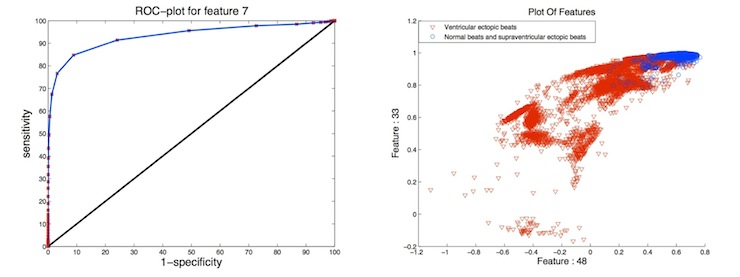Detailed investigation of feature dependencies in order to improve a QRS complex classification system
- chair:Digital signal processing
- type:Student research project
- tutor:
- person in charge:
-
Motivation
Cardiac arrhythmia as one of the most frequent cardiac diseases can be initiated by heart beats which do not originate from the sinus node.In order to diagnose this disease the electrocardiogram (ECG) is commonly used. It is important to find these ectopic heart beats and to classify them correctly. In an existing algorithm for automatic beat detection and classification, 55 rhythmical and morphological features were developed to distinguish between the classes normal beat, ventricular ectopic beat and suptraventricular ectopic beat using a support vector machine (SVM) as classifier. In a previous work, the relevance of each feature for the classification task was evaluated as it was assumed that noisy features may confuse the classifier and do not yield relevant information. This led to a new SVM that only uses 36 of the original features. The classification results have been improved by this feature evaluation. A correct rate of 98.574% has been achieved.

Description of the research project
Large scale evaluation of the new SVM
The first task during this research project is to test the performance of the new SVM on new datasets. Signals of the MIT-BIH-Arrhythmia-Database and of a dataset coming from an study on ventricular ectopic beats will be used here.
Deeper look at feature dependencies
Furthermore, the feature evaluation done in a previous thesis should be continued focusing on the detailed investigation of the dependencies among the features. Therefore, one evaluation method of a previous thesis should be extended. Its principle is to have a closer look at all in a first run-through falsely classified beats. Besides, it does not seem to be necessary to use features that are related to each other too closely and deliver nearly the same amount of information (e.g. correlation coefficient and maximum of cross correlation). As one probably needs only one information-rich attribute of every „family“. In addition, the relation among the features may be investigated using a dendrogram.
Reformulation of old features
Additionally, a detailed view on the features that were left out after the previous evaluation should be taken. The question whether these features can be modified and therefore rescued in any way should also be considered.
Creation of a new more powerful SVM
Finally, after combining the results of the previous evaluation and the new investigation of the feature dependencies, a new SVM using selected features should be trained and tested.
Report
In the end, a publication is conceivable as well as a presentation of the results at a conference. Additionally, a written documentation of the research project is planned.

